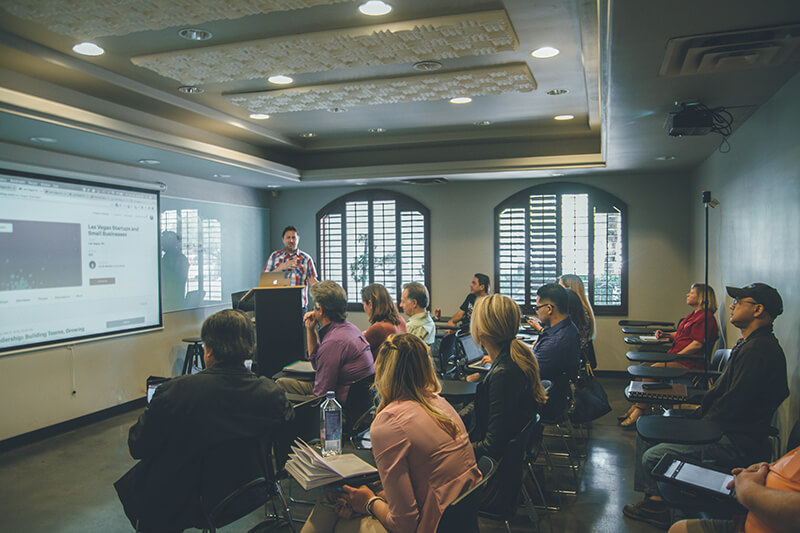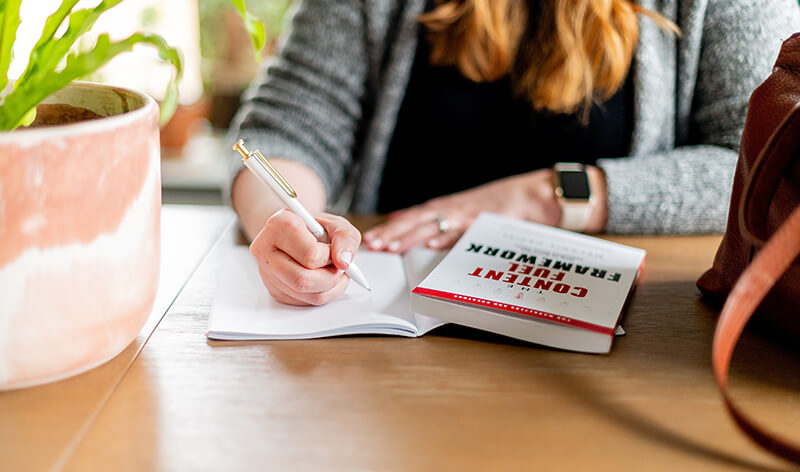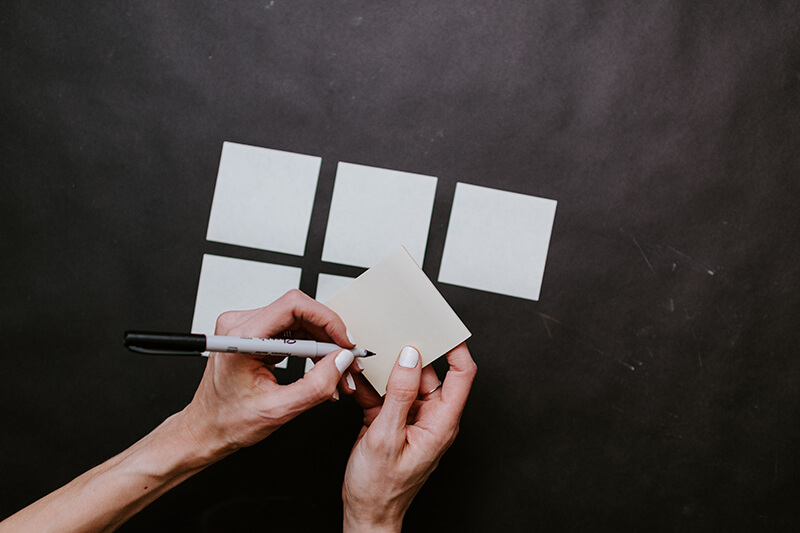
How to Take Notes in College: The Ultimate Guide to Help You Ace Your Classes
 You may have learned how to take notes in high school, but when you get to college or university, everything hits a little different. Your professors aren’t there to guide you along and tell you what’s going to be on a test, or identify which information is important. At this point in time, all of that is up to you to decide.
You may have learned how to take notes in high school, but when you get to college or university, everything hits a little different. Your professors aren’t there to guide you along and tell you what’s going to be on a test, or identify which information is important. At this point in time, all of that is up to you to decide.
That’s where your notes come in. Taking better notes in class is a crucial part of your academic success, and something you’re going to be doing a lot of in the next few years – longer if you’re taking a post-graduate program.
But how do you know that you’re doing it well enough? When you start your freshman year, you’re thrown into this new world and your lecture structure is going to be very different from what you’re used to. A lot of information is going to come at you at once, and you need to be ready to keep your notes organized.
This guide will tell you what you need to know to learn how to take notes that will help you in your study sessions, while writing your essays, and everything in between.

The Importance of Learning How to Take Notes
Learning how to take notes the right way will be the key to your success in college or university. It’s a great way to make sure you maximize your performance at school and get the best grades you can in your courses.
When you attend a lecture, you’re expected to be jotting down the key points of information that your professor is discussing. Sometimes this information is available in the textbook or lecture slides, but most of the time you’re expected to remember it on your own.
Notes are extremely important when it comes to everything from studying for tests and exams to writing papers, essays, and even presentations. When you don’t take great notes, you won’t have a lot to go with during crunch time. Even worse, no one wants to sit through a lecture only to get to your study session and find that you’re missing pieces of information that are crucial for your exam.
Effective note taking skills will also take you through your career, especially if you plan on working in an environment where there will be meetings, documents, paperwork, and reports. Taking great notes is a key way to impress your boss and be great at your job in the future.
What Are the 5 Rs of Note Taking?
The first thing you should know when learning how to take notes in college is the 5 Rs of note taking. According to Penn State University, these are the 5 Rs:
1. Record: Write down any important or relevant information during your lecture. Your professor won’t always tell you which information is meaningful, so do your best to learn how to determine what matters and what’s just extra details.
2. Reduce: After your lecture is over, go over your notes and condense them into a summary with the key points. Read our blog on how to write a precis if you need help with the summarization.
3. Recite: During your study sessions, you want to be able to recall or recite the information without looking at your notes. Use them for memorization.
4. Reflect: As you read over your notes later, you want to think about them in a critical way and be able to relate them to the overarching themes of your course and even the world.
5. Review: Always take some extra time to review the notes you’ve taken after each lecture while they’re still fresh in your mind. This way, if you forgot to write something down you can add it in and you’ll also get a head start on studying.

Typing Your Notes in Class vs. Using a Pen and Notebook
One key decision you’ll have to make when learning how to take notes in class is how you will take down those notes. While most students these days tend to bring their laptops and take notes in class that way, many students prefer the good old pen and notebook technique. Both methods have their advantages, but one is better than the other when exam day rolls around.
There is scientific evidence that proves that writing notes by hand helps you remember them more effectively. In one study by the University of California, researchers had students split into two groups – one group took notes by hand in a lecture, while the other group used a laptop and typed them. The researchers quizzed the students on the lecture material half an hour after class, when they had no time to review, and then again one week later, when they’d had the whole week to study. During both quizzes, the group that took notes by hand got better scores.
The reason for this is that writing your notes out by hand utilizes your muscle memory and motor function, which forces you to pay attention to what you’re writing down. As a result, the information sticks in your brain more effectively. Mindlessly typing out what your professor is saying won’t make you absorb that information as well – or at all.
Sure, writing out all of those notes is likely going to leave you with some hand cramps and typing them lets you organize them as you go. But bringing your laptop can also give you a really easy way to get distracted in class, and you’re less likely to pay attention to what your professor is saying if you’re just typing out what they have on their slides.
Ultimately, the way you choose to take down notes in class is entirely up to you, but it is scientifically proven that writing them by hand is more effective for studying and memorization.

What is the Best Way to Take Notes?
When it comes to learning how to take notes, there is no one-solution-fits-all that works for every single student. Some people are visual learners, while others prefer to read text or listen by ear. The same goes when you’re figuring out how to study effectively – you need to know your own learning style first before you commit to one method.
There are a variety of different methods of effective note taking that you might choose to use. Sometimes you may find that the method you use isn’t really working out for you. If that’s the case, switch it up and try something else instead.
To take proper notes, you need to gather a few key supplies first. You will need the following things at the minimum:
● Pens
● Highlighters
● Notebooks
● Textbooks
● Lecture slides
● Sticky notes
● Cue cards or index cards
● Any other course materials
Some of these supplies may apply only to in-class note taking, while others will be more useful during your at-home study sessions and lecture review time. Regardless of when, you’ll need all of them at some point in time, so put them on your back to school checklist.

How to Take Notes: Proven Strategies For Effective Note Taking
In the next few sections, we’ll cover a few different proven strategies for taking good study notes that appeal to a variety of learning styles and lecture styles. As we mentioned before, there are so many ways to take better notes and sometimes it takes a bit of trial and error to determine what works best for the way you learn and absorb information.
Don’t confine yourself to just one style of taking notes, either. You always have the ability to mix and match different methods and styles and morph them into something that is appealing to you. Since you’re the one using them, you have the freedom to do what works for you.
The Outline Method
When learning how to take notes, it’s important to know the basics first – so, let’s start there. The outline method is the most common technique used for taking notes in college and university lectures. This is because it’s simple, easy to do, and is very effective when it comes to study time.
The outline method for taking notes is very similar to the way that you would make an outline for an essay. You’ll use headings, subtitles, and bullet points to jot down points of information about a specific topic or subtopic. Use themes and topics as your headings and separate each chunk of bullet points by theme.
This is typically the easiest way because your professor’s lecture slides are likely also broken down by topics and subtopics. Use the topics on the slides to determine when to break up your bullet points into the next subheading. When your professor gives you secondary information, you can use indents under each bullet point or heading to identify that this information is a sub-point to something else.

The Cornell Method
It’s a little more complex than just jotting down bullet points, but the Cornell Method works well for those who need a little bit more of a systematic approach. If you’re more of a logical learner, this is the method you’ll probably find the most effective.
To use the Cornell Method, start by dividing a sheet of paper up into three sections. On the left, leave a column about 2 inches wide, so the area on the right side of the column is about 6 inches wide. Then, on the bottom, leave another 2 inches of space. Ultimately, your paper should have a thin vertical rectangle on the left, a thicker vertical rectangle on the right, and then a horizontal rectangle on the bottom.
Write your notes in the wider column on the right when you’re in class. Use the thinner left side column to write down cues and keywords that are associated with the more detailed notes. This will help you later on when it comes time to start studying and memorizing. At the bottom, in the horizontal column, add a summary. It doesn’t have to be a long one – just a few sentences that describe the content so it’s easier to go back and find information.
The Mind Map Method
You’ve likely made a mind map before when you were in high school or even elementary school. The mind map method for taking notes in college lectures is similar, but a little more detailed. This is an effective note taking technique for visual learners because it helps you clearly see the connections and relationships between topics, sub-topics, and supporting details. It’s also a great method to help you keep your notes organized if your professor likes to go off on side tangents during lectures.
Start with your topic or theme in the middle of the page. Circle it, and then have lines branch out from there going in all directions. At the end of each line, you’ll write and circle a major point or sub-topic. Then, each of those sub-topics will branch out to smaller bubbles that have more information or points about them.
Here’s an example: let’s say you’re taking notes in a lecture about the French Revolution. In the middle, you’ll write “French Revolution” and the years your lecture is covering. Branching out from there, you’d want to have circles that have sub-themes such as the Ancien Regime, the wars and battles, the rise of terror, the constitutional documents, and so on. From each of those points, you’d start listing off further details until you have one big map.

The Bullet Journal Method
If you’re a visual learner, the bullet journal method will be a great fit for you. However, be warned – this method is not effective for those who can only focus on one thing at a time. If you want pretty, visual, aesthetically pleasing notes, but you can’t multitask in class, you can always use one of the other methods above and then turn those notes into a bullet journal later on.
First of all, let’s answer the question you likely have in mind: what is a bullet journal? If you’re already into journalling, you’ve probably already heard of this because there are millions of Instagram posts dedicated to beautiful bullet journal styles and designs. However, if this is new to you, a bullet journal is a technique invented by web designer Ryder Carroll. Basically, you take a blank journal and number each page with an index at the front. From there, you can have each page include lists, logs, mind maps, bullet notes, question points, or other styles of note taking blended into one visually appealing design.
You can watch a free tutorial from Ryder himself here if you want more information or to see some examples of this kind of system in action.
The Sentence Method
A less common technique, the sentence method is pretty straightforward and doesn’t require a specific format or setup. All it involves is writing down information in your notes in full sentences, with one sentence on each line. When your professor starts talking about something new, start a new sentence on the next line.
The sentence method can be a little disorganized at times, and usually you’ll need to come back to it to re-write and organize everything later on. However, it’s great for taking good class notes when you have a professor who likes to throw a lot of information at you during a lecture and you don’t always know how it fits in until later on.
Your sentences don’t have to be completely full, either. You can use point form sentences and abbreviations so that you’re not wasting time trying to catch up, especially when your professor starts talking faster than you can write.

The Chart Method
This method can be a little difficult and is best used if your lectures are typically structured chronologically or in a very clear linear order, such as in the humanities. It might also take some trial and error when you begin because it’ll take some time to get used to putting things in their proper categories. However, this is a great tool for those who are hands-on learners because you’re actively processing and sorting information as you hear it.
To use the chart method, you start by setting up your paper with vertical columns, each with its own heading. Usually the heading would be a category, such as “dates,” “key figures,” “countries involved,” or “significant events.” The first heading on the left will be whatever you use for topics. So, for example, if you’re in an art history class looking at various pieces of art from the same time period, that first column will be for the name of the art piece.
After you’ve made your vertical columns and headings, go down and draw horizontal columns so you have squares. Essentially, you’re setting up your paper like a table or chart. As you start to take your notes in class, write down the information in the corresponding columns or squares.
The Lecture Slide Method
If all else fails, try the “lazy” method of printing out your lecture slides and bringing them to class to take down notes right on the same paper. It’s not the most elegant method for taking notes, but it’s certainly the fastest and easiest.
While this is another easy one to use, it will depend on your professor and the way they structure their lectures. Some professors don’t always give you the lecture slides ahead of time, and others don’t always go off what’s written there word for word.
The downfall of simply jotting your notes down on the provided lecture slides is that you probably won’t absorb as much of the information in class because you won’t have to write it down. That leaves tons of room to space out or absent-mindedly read the text without actually retaining it.

Quick Tips For Taking Better Notes in Class
Regardless of which note taking strategy works best for you, here are some quick tips that will help you take great notes and get better grades:
● Record your lecture if you’re allowed to so you can go back and listen later for anything you may have missed.
● Don’t assume you’ll remember something your professor mentions in class. Always write everything down so you’re covered if you forget anything.
● Use a serif type font when you’re typing up your notes. There is scientific research that shows that these fonts improve memory and information retention.
● When you take down notes by hand, don’t try to copy what your professor says word for word. Try to pick out the key points so you don’t miss important information while you’re trying to keep up.
● As you read through textbooks and study materials, add points to your in-class notes to create a more effective and helpful study guide. This way, you don’t have to go back through every file or document when getting ready for a test. Speed reading can be a great technique to help you with this.
● Don’t be afraid to raise your hand and ask your professor to repeat something if you missed it. You might not remember it by the time you go back to fill in the blanks, and you won’t get another opportunity to have it explained to you.
● If you take notes by hand, practice your handwriting so you can always read it easily later on.
● Don’t focus on writing out full sentences in your notes. Use short forms of words and create your own set of symbols and abbreviations to cut down time. For example, use a + instead of “and” or “w/” instead of “with.”
● Jot down any questions or areas you’re confused about in the left margin column of your notes so you can go back and review it later or ask your professor during office hours.
● Dedicate a section of your notes, or a few pages at the back of the notebook, to coming up with practice questions during lectures. This way, you have some premade practice questions to use when you’re studying later.
● Leave the first few pages in your notebook blank so you can go back and make a table of contents for your notes. This way, you can go back later on and find specific information easily.

You Can Learn How to Take Notes, or You Can Call in the Experts Instead
Haven’t figured out the most effective note taking strategy yet? Maybe you’ve nailed down your notes but don’t have the energy to use them. Regardless of the reason, if you aren’t feeling up to tackling your workload, you don’t have to.
Homework Help Global is a custom essay writing service that will take care of all of your assignments for you. We have a team of experienced, highly educated, and knowledgeable academic writers and scholars who are on hand and ready to get the work done. From essays and research papers to editing, lab reports, and PowerPoint presentations, we can help you maintain your grades no matter what type of assignments you get.
Order your next assignment now in just a few short steps, or get a free quote for your paper from our operations team.
Share:

